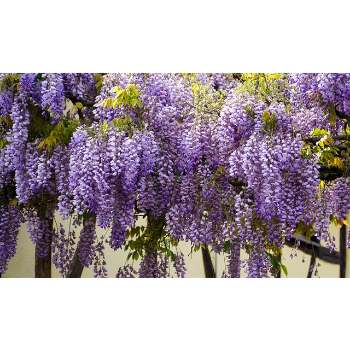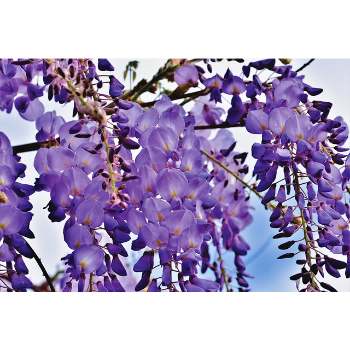Wisteria generally blooms once a year, usually between April and June, but it could have a second bloom in August. But the exact time can change based on things like area and the type of wisteria.
Your unique wisteria variety is one of the major factors. Certain unique varieties of wisteria could bloom in various ways, which might lengthen the flowering season.
Your location and the environment where you live might also have an impact on when your wisteria blooms. Weather and temperature might vary from place to place, causing wisteria to blossom a little bit early or later than the usual April to June window.
There’s a potential of a second flush in August for those who are itching to take in wisteria’s magnificence once again. For wisteria fans, this additional bloom might be a nice surprise since it is not as frequent.
But growing wisteria requires time, particularly when starting from specialized forms like grafted or stacked plants. When cultivated from seed, certain kinds may take even longer to bloom than others that don’t until they are at least 5 to 10 years old. As a result, growing wisteria calls for a sustained effort, but the beautiful flowers it produces are well worth the wait.
Also Read :
How Long Do the Wisteria Bloom? Everything You Need to Know
When Does Wisteria Bloom in Different States?
What Does Wisteria Smell Like? (All You Need to Know)
How Fast Does Wisteria Grow? (15 Ways to Improve Growth Rate)
How to keep wisteria blooming?
Here’s a detailed guide on how to keep your wisteria in full bloom:
- A key factor in pruning is timing: certain periods of the year are ideal for doing it. First, a few months after it has flowered in the middle of summer, trim your wisteria. For the purpose of reducing overgrowth and promoting the formation of flower buds for the next season, this first pruning is crucial. Best time to prune again: just before the plant starts to leaf out, in late winter or early spring. This directs the wisteria’s energy into blooming instead than foliage.
- Shape and Structure: Take note of your wisteria’s shape and structure while trimming. The goal is to have a trained vine that spreads out along its support system in a horizontal manner. Pruning side branches that attempt to grow vertically on a regular basis will encourage this natural growth pattern. This facilitates a more effective use of the plant’s resources in preparation for blooming.
- fertilizing: Although trimming is essential, fertilizing also affects wisteria’s ability to blossom. Use a high-potash fertilizer in the spring to promote more blossoms and inhibit overbearing leaf development. A healthy diet may have a big influence on how many and what kind of blooms there are.
- Watering: Especially in the dry months, make sure your wisteria gets enough water. Sufficient and even moisture content in the soil may encourage stronger roots and more beautiful flowers. On the other hand, keep in mind that overwatering might result in excessive vegetative growth at the price of flowers.
- Maintenance: Look out for straggling or overgrown branches throughout the growth season. To preserve the form and size of the plant, trim these branches in February during the warm weather. By taking this precaution, you may help keep the wisteria from becoming too wild and uncontrollable.
- Maturity Matters: Give your wisteria some time to bloom. Sometimes inadequate blossoming is the result of immaturity. The majority of wisteria plants need many years to fully establish themselves and begin producing copious amounts of blossoms. The outcomes will be well worth the wait with patience and regular maintenance.
- Control Spread: Keep a regular pruning program in place to stop your wisteria from growing out of control. To properly control its growth and form, prune it twice a year.

How to get a second bloom in wisteria?

To get a second bloom from wisteria, you need to prune it in a smart way. In the summer, cut back most of the side shoots from this year to 5 or 6 buds, about two months after the first flowers bloomed. Then, in the winter, cut these same stems back even more, leaving just two or three buds at the base. This trimming schedule encourages flowers to grow for the next growing season.
here are the two main phases: a summer trim and a winter trim :
- Summer Pruning (around Two Months After Initial Flowering): Summer pruning should begin around two months after the wisteria’s first flush of blooms. Concentrate on the majority of this year’s side projects. Cut these side shoots from the main stem or branch back to a length of 5–6 buds. You are encouraging the plant to focus its energy on forming new growth and flower buds for the next season by doing this.
- Winter Pruning (Usually in February): We must do the second round of pruning in the winter, which is usually a pleasant day in February. This stage is just as important for guaranteeing a second bloom. Cut back the same branches you clipped in the summer even farther in winter, leaving just two or three buds at the base of the branches. By trimming the wisteria more severely, you may encourage it to bear the new growth and blooms that will adorn your yard next season.
It’s important to remember that wisteria, like many other plants, benefits from year-round maintenance. Pay attention to the general health and surroundings of your wisteria in addition to the trimming schedule. Make sure it gets enough sunshine and nutrition, and monitor the amount of nitrogen in the soil—too much nitrogen may prevent blossoming.
The fragrant show of blooms in late spring and, on occasion, a second flush in August are further indications that some wisteria types, including “Amethyst Falls,” have been known to spontaneously produce a second flush of blossoms. A well planned pruning strategy may still maximize the flowering potential of these kinds, even if they might need less attention overall.
How many years does it take wisteria to bloom?
Most wisterias take three to five years from the time they are planted to start blooming.
Pruning is an essential part in forcing wisterias into bloom. Pruning your vine or tree every year is necessary to encourage blooms. After four to five years of planting, this method—which may be quite labor-intensive—usually produces results.
To begin with, you may need to wait longer if your wisteria is growing from seeds. These plants may not bloom for up to 20 years, or they may never bloom at all. Appropriate planting methods, along with careful trimming and maintenance, may greatly speed up the process.
With wisterias, patience is essential. After first planting, it’s not unusual for them to take two or three years to begin producing their lovely flowers. The result is worth it: an abundance of lengthy flower clusters packed densely with blossoms. Some gardeners have even reported waiting up to 15 years or more for their wisteria vines to eventually reach the flowering stage.
Furthermore, wisterias need a longer maturation period before they are old enough to bloom, usually taking 7 to 15 years. Striking a balance between promoting growth and preserving the ideal circumstances for blooming is crucial since overpruning is a typical error that may postpone blossoming.
Types of Wisteria
I’ve learned about various types of wisteria, and there are around ten species, including Japanese wisteria, Chinese wisteria, American wisteria, and Silky wisteria. Each has its unique characteristics, and the choice depends on your garden’s specific needs and climate.
Here’s a detailed comparison of some of the most notable types:
- Japanese Wisteria (Wisteria floribunda):
Renowned for its breathtaking flower clusters that cascade.
Flowers come in a variety of hues, from white to purple.
robust growth, perfect for trellises or pergolas.
- Chinese Wisteria (Wisteria sinensis):
It has longer bloom clusters than wisteria from Japan.
Usually lavender to violet-blue in color.
Growth is a little less vigorous than that of Japanese wisteria.
- American Wisteria (Wisteria frutescens):
Originally from the United States.
Less hostile and smaller than Asian types.
There are tones of blue to purple in flowers.
- Silky Wisteria (Wisteria brachybotrys):
renowned for having smooth, luxuriant foliage.
Pretty blue or white flowers.
a more compact growth pattern that works well in cramped areas.
- Kentucky Wisteria (Wisteria macrostachya):
originating in the American Southeast.
has lovely blooms that are purple-blue in color.
Accepts a greater variety of soil conditions.
- Amethyst Falls Wisteria:
An American wisteria cultivar.
Its compact growth makes it ideal for tiny gardens or containers.
Displays vivid lavender-blue blooms.
- Aunt Dee Wisteria:
One more cultivar of American wisteria.
Slender stems with lovely blue-lavender blooms.
- Blue Moon Wisteria:
A resilient variety with striking violet-blue blossoms.
Able to withstand illness and low temperatures.
- Cooke’s Purple Wisteria:
Has lengthy clusters of bright purple blooms that resemble grapes.
Robust growth and an amazing show of colors.
- Grande Diva Wisteria:
A cultivar of Japanese wisteria with big, eye-catching blossoms.
Flowers are usually violet-blue or pastel purple in color.
Final thoughts
In conclusion, I hope you find this article “How Often Does Wisteria Bloom” helpful. As you now know wisteria generally blooms from April to June, although the precise date might vary depending on a number of variables, including the kind of wisteria, the location, and the local climate. The appeal of wisteria’s flowers is also a wonderfully beautiful experience that develops in its own time for those who are patient enough to wait.
